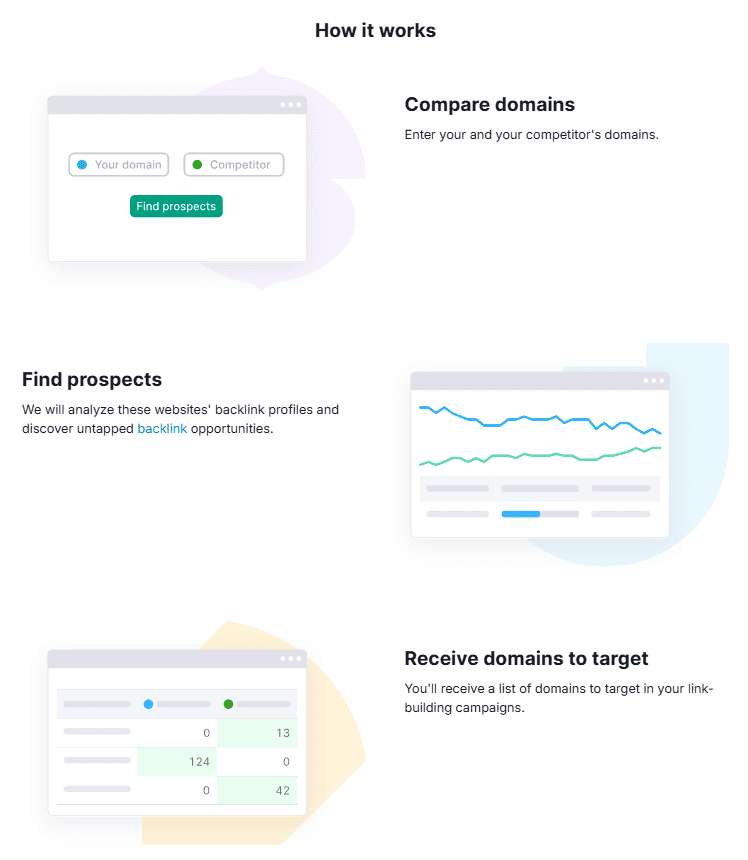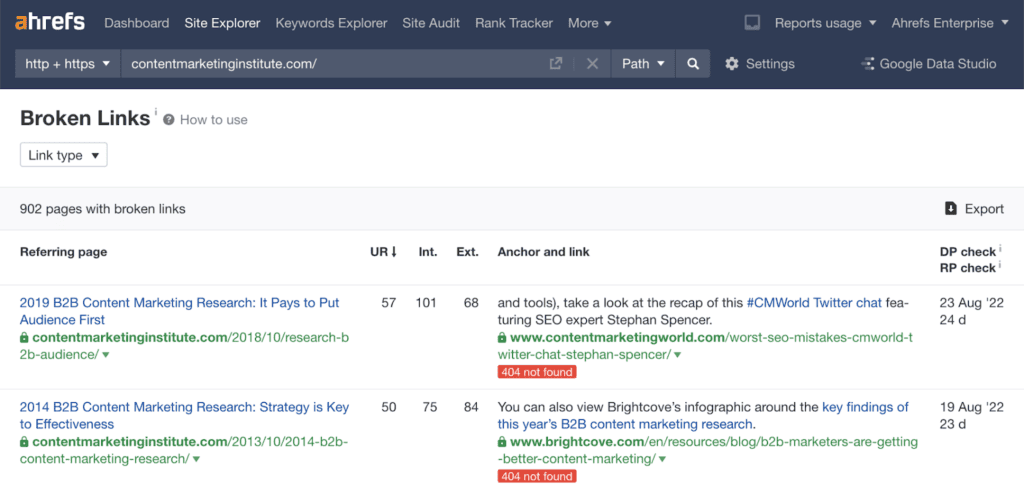Ever wonder why your competitors keep outranking you, even when your content feels just as good? The answer often comes down to backlinks. Search engines see them as votes of trust. The more high-quality votes your site gets, the higher you can climb in the results.
That’s where learning how to get competitor backlinks changes the game. Instead of guessing where to build links, you look directly at what’s already working for others in your space. By studying their backlink profiles, you uncover proven opportunities to raise your domain authority and grow organic traffic.
Follow along, as this guide breaks the process down step by step.
Highlights
- Start with the right competitors. Pinpoint domain and page-level rivals so you know whose backlinks are worth chasing.
- Use the right tools. Platforms like Semrush, Ahrefs, and Moz help you uncover backlink data and spot patterns that matter.
- Find the backlink gap. Discover domains linking to your competitors but not to your own website. These are proven opportunities waiting for you.
- Turn data into action. Reach out with guest posts, fix broken links, or get featured on resource pages to secure those backlinks.
- Keep refining. Track your wins, review your backlink profile often, and refine your strategy to maintain a high search ranking.
Why competitor backlinks matter
If you want to climb in search results, copying what already works is smarter than starting from scratch. That’s why competitor backlinks should be part of your link building strategy to drive more ROI.
When your competitors rank above you, many owe that to strong external links pointing to them. These links pass link equity, help raise domain authority, and elevate page authority.
Websites with high-quality backlink profiles tend to outperform those with weak link profiles. Backlinko analyzed over 11.8 million search results and found that the #1 ranking page tends to have about 3.8x more backlinks than results ranked 2-10.

By learning how to get competitor backlinks, you reverse engineer what’s already proven to work in your niche. You don’t waste time guessing. Instead, you discover link building opportunities that directly impact your visibility.
How to get competitor backlinks: 6 proven steps
To find competitor backlinks, you need a set of steps that show both the big picture and the small details. Some methods reveal who you’re really competing with. Others indicate the exact sites, giving them an edge.
Step 1: Identify your true competitors
Before you start building links, you need to know who you’re really up against. Competitor research sets the stage for everything else. If you target the wrong sites, you’ll chase the wrong backlinks. Get this step right, and the rest of the process becomes much easier.
There are two kinds of competitors to focus on. Each has a different role in your backlink strategy. By analyzing your competitors, you’ll see who actually deserves your attention and which backlink sources they’re winning.
Domain-level competitors
Domain-level competitors are sites that compete for the same keyword and target similar keywords. They’re often the authority players in your space.
Tools like Ahrefs’ Site Explorer can help you uncover these domains. They show you where the overlap in keywords happens, and which sites are taking up the rankings you want.
These competitors typically have backlink profiles that reflect the broader landscape of your industry. Studying them gives you benchmarks for link quality, volume, and authority.
For example, if you run a fitness blog, your domain-level competitors might be large health and wellness sites that publish a wide range of fitness and nutrition content.
Page-level competitors
Sometimes, the real fight isn’t with an entire site. It’s with a single page. Page-level competitors are the individual pieces of content that rank for the exact keywords you’re after.
Finding them is simple. For each target keyword, look at the first 5–10 results. These are the ranking positions you want to achieve. Even if the site itself isn’t a direct competitor, it’s still competing for your traffic.
You write a blog post about “How to Optimize Your Website for SEO”. The top pages ranking for that keyphrase are your competitors. These could come from a magazine, a personal blog, or a general health site.

Screenshot provided by the author
Step 2: Collect competitor backlink data
Once you know who your competitors are, the next step is to examine their operations closely. To win comparable backlinks, you first need to see where your competitors’ backlinks originate. This is where data makes the difference.
Which tools to use
For a winning SEO technique, you need to choose platforms that provide you with full details for every link. Popular options include:
- Semrush’s Backlink Analytics Tool
- Moz’s Link Explorer
- SE Ranking’s Competitor Analysis Tool

For any platform you use, you have to enter the competitor’s domain. Then, you get a list of their referring domains, the backlink text they use, and whether those links are dofollow or nofollow.
You can also analyze popular key metrics, like domain authority and spam score. All this data not only tells you how many links a site has, but how strong and safe those links are.
Export a backlinks report
A backlink report helps you closely examine your competitors’ backlink profiles. This should include:
- The domains linking to them
- The anchor text they use for each link
- The type of link, if it’s dofollow or nofollow
- The page authority or URL rating of the linking page
You can filter and export the data if you find it easier to spot patterns.
For example, you might notice that one competitor earns links from several University resource pages. However, another option might be to get coverage from industry news sites. Both are signals that you can target similar opportunities for your own website.

Clean and evaluate link quality
You may find that some links originate from low-quality sites. Others may be irrelevant or look spammy. Go through your report and flag anything that doesn’t make sense.
Be cautious of sites with a high spam score or that use unnatural anchor text. And keep in mind that nofollow links aren’t bad. But they don’t have the same SEO value as dofollow links.
Focus on the links that really drive results. These are the backlinks that help your competitors climb in search engine rankings.
Step 3: Find the backlink gap
The backlink gap is simply the set of domains linking to your competitors but not to you. Spotting these sites gives you a list of proven link sources you haven’t tapped yet.
Use backlink gap tools
Tools like Ahrefs’ Link Intersect or Semrush’s Backlink Gap make this easy. You enter your domain and your competitors’ sites. The tool then shows which referring domains link to them, but not to your pages. This is where you’ll uncover more ways on how to get competitor backlinks that actually move rankings.
For example, let’s say three of your competitors all earned links from a popular industry magazine. You don’t have that link yet. That’s a clear sign the magazine is open to covering sites in your space, and you should consider pitching your own content.

Prioritize high authority domains
Not every domain is valuable. Prioritize domains that:
- Link to several competitors (shows they’re open to linking)
- Are of high authority and relevant to your niche
- Have a clean backlink history
Imagine three of your competitors are linked by a niche news site. That’s a prime target. This means that it’s probably open to collaborating with website owners within your niche. It’s likely to be familiar with your content.
Step 4: Discover easy backlink opportunities
Not every backlink takes months to earn. Some are easier wins that you can spot quickly and act on. These opportunities help you build momentum while you work on bigger, long-term links.
Broken link building
Broken link building is one of the fastest ways to get competitor backlinks. Look for broken links on sites that already link to your rivals. Replace their outdated resources with your fresh content, and you’ll often land an easy win.
Imagine a popular marketing blog linked to your competitor’s guide from 2018. The link now returns a 404 error. You can create an updated guide and suggest it as a replacement. Site owners usually appreciate it when you help them fix broken links, so this method often works.

Guest posting
No “How to get competitor backlinks” guide would be complete without mentioning guest posting. It’s a crucial tactic in acquiring high-quality backlinks.
When you review your competitors’ backlink profiles, you’ll often see links from guest articles. These are easy to replicate because they show the domain already accepts outside contributions.
Say you notice your competitor has a guest post on a SaaS industry blog. That tells you the blog is open to pitches. You could approach them with a fresh, high-value topic and include a natural link back to your own content.
Resource pages and link hubs
Many industries maintain resource pages or curated “best of” lists. If your competitors are listed, there’s no reason you shouldn’t be, too. These pages are designed to point readers toward useful tools, guides, or research.
For example, suppose you find a medical resource page linking to three of your competitors’ tutorials. You can reach out and suggest your guide as an additional resource. If it adds value, there’s a good chance they’ll include it.
Step 5: Execute your outreach strategy
Finding link building opportunities to outrank competitors is only half the work. To turn those into real backlinks, you need a smart outreach link building plan. The goal is simple: connect with site owners in a way that feels personal and valuable, not pushy.
Content outreach email
A good content outreach email should be short, polite, and clear. Mention the page you’re referring to, explain why your content is useful, and make the request easy to act on.
If you find a competitor’s outdated link on a blog, you could write:
“Hi [Name], I noticed your post on [Topic] links to [Competitor’s old article]. I recently published an updated guide with the latest data and tips. I think it could be a strong addition for your readers. Would you consider updating the link?”
This approach shows respect for their time and highlights the value you’re offering.
Build linkable assets
Outreach works best when you have something worth linking to. Think about linkable assets, like long-form guides, fresh case studies, or original research that adds to the conversation.

For instance, you run a marketing blog. Instead of asking for links to a generic post, you could publish new survey results on social media about brand awareness. That kind of data gives site owners a reason to link to you over a competitor.
Monitor link acquisition
Once outreach pays off, keep track of your wins. The tools we’ve already mentioned make it easy to see when a new backlink appears.
For example, maybe you secured a guest post link, but later find the site also linked to your resource page in another article. Tracking helps you spot these extra wins. It also shows you when a link disappears, so you can follow up if needed.
Stay alert for toxic links pointing to your site. If a spammy domain suddenly links to you, use a disavow tool to protect your backlink profile.
A consistent outreach and tracking process keeps your efforts organized. Over time, it shows you which tactics land the best links — and which ones to drop.
Step 6: Track, measure, and refine
Backlink building doesn’t end once a link goes live. The real value comes from tracking how those links affect your site over time. Use Google Search Console to see if new links are improving your search rankings or growing your organic traffic.
Make this a regular habit. Run a competitor backlink analysis every quarter. This lets you discover new opportunities and spot shifts in your niche.
If certain tactics consistently deliver, focus more there. If others fall flat, adjust your approach. Treat backlink building as a cycle of testing and refining. That’s how you stay ahead of competitors and keep growing.
Ready to win competitor backlinks?
Mastering how to get competitor backlinks is one of the smartest ways to grow your rankings fast. By studying your rivals, spotting the backlink gap, and reaching out with the right strategy, you’ll win links that actually drive results.Ready to take the next step? Book a call with uSERP and see how our team can help you scale link building that delivers real growth.


